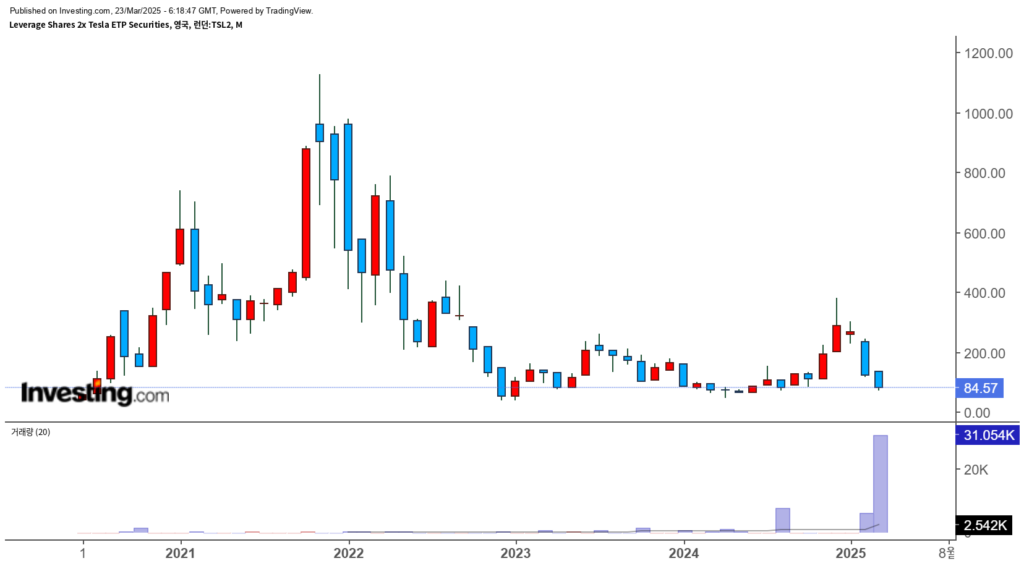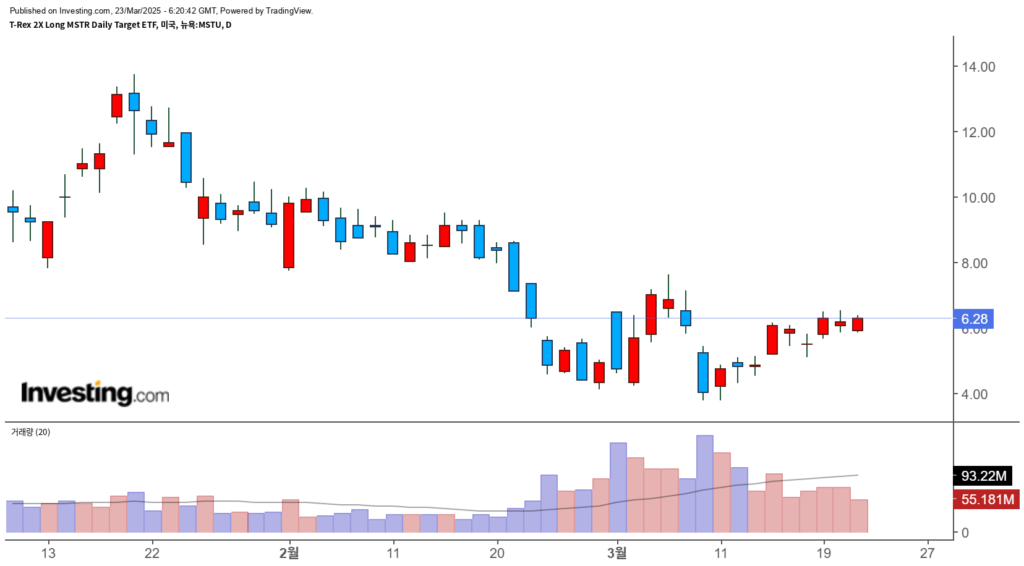The Meteoric Rise and Spectacular Crash of Leveraged Single-Stock ETFs: A Cautionary Tale for High-Risk Investors – In 2023, Wall Street’s fascination with high-octane trading vehicles reached a fever pitch as leveraged single-stock ETFs amassed billions in investor capital. These products, designed to amplify daily returns through borrowed money, turned ordinary market swings into roller-coaster rides.
But by early 2024, the euphoria has given way to despair: funds tied to volatile stocks like MicroStrategy and Tesla have plunged 80% or more from their peaks, erasing fortunes and igniting debates about the risks of financial innovation. This deep dive explores how these ETFs captured the zeitgeist, why they collapsed, and what their future holds in an increasingly skeptical market.
What Are Leveraged ETFs? Mechanics, History, and Evolution

A. The Engine Behind the Volatility
Leveraged ETFs use derivatives and debt to magnify daily returns, typically offering 2x or 3x exposure to an index or single stock. For example, the ProShares UltraPro QQQ (TQQQ), the largest leveraged ETF with $22 billion in assets, seeks to deliver triple the Nasdaq-100’s daily movement. However, their design inherently favors short-term traders: daily rebalancing leads to volatility decay, where compounded losses during downturns erode long-term returns.
B. A Brief History
Leveraged index ETFs debuted in 2006, but regulators only greenlit single-stock leveraged ETFs in 2022. These newer funds targeted retail investors’ obsession with meme stocks and tech giants. By 2023, assets in leveraged ETFs surged 51% to $134 billion, per Morningstar, driven by products like the 2x MicroStrategy ETF (MSTU) and 2x Tesla ETF (TSLL).
C. Regulatory Gray Zones
The SEC’s 2022 approval of single-stock ETFs surprised many, given concerns about concentration risk. Critics argue these products blur the line between speculation and investment, yet providers like Direxion and Defiance ETFs market them as tools for “sophisticated” traders.
The 2023 Frenzy: How Leveraged ETFs Became Market Darlings

A. Case Study: MicroStrategy’s Bitcoin Bet
MicroStrategy (MSTR), a software firm turned Bitcoin proxy, saw its shares soar 300% in 2023 as crypto rallied. Leveraged ETFs like MSTU capitalized on this, delivering 10x returns from September to November. Retail investors flooded in, with MSTU attracting $500 million in early 2024 inflows despite an 83% drop from its peak.
B. Tesla and the Day-Trading Crowd
Similarly, the 2x Tesla ETF (TSLL) became a favorite for traders betting on Elon Musk’s EV giant. At its November 2023 peak, TSLL held over $1 billion in assets—before collapsing 80% as Tesla’s growth narrative faltered.
C. Psychological Drivers: FOMO and the Illusion of Control
Reddit forums and social media fueled the mania, with users boasting about overnight gains. “I turned 10kinto10kinto100k in a month!” posts masked the risks of holding leveraged products through volatility.
The Unraveling: Billions Lost, Lessons Ignored

A. The Math of Disaster
Leveraged ETFs’ daily reset mechanism wreaks havoc over time. For instance, while the Nasdaq-100 rose 20% from 2021–2024, TQQQ fell 25% due to 2022’s bear market. Single-stock ETFs face even steeper cliffs: MSTU’s 83% drop since November 2023 erased $1.7 billion in investor capital, per Morningstar.
B. Retail Investors: “Literally Sick to My Stomach”
On Reddit’s r/investing, one user lamented buying 200 MSTU shares at 200each,nowworth200each,nowworth29.80. Others admitted treating these ETFs like lottery tickets, ignoring prospectus warnings about holding periods.
C. Institutional Warnings
Morningstar’s Jeffrey Ptak likened the ETFs to a “thresher,” grinding up investor capital. “These products are structured to fail over time, yet inflows continue,” he noted. Academic studies, including a 2022 MIT analysis, found that 90% of leveraged ETF buyers lose money within a year.
Expert Insights: Why the Bloodbath Isn’t Over
A. Regulatory Crackdowns Loom
Former SEC commissioner Robert Jackson warns, “Single-stock ETFs are accidents waiting to happen.” The EU has already banned them, and U.S. lawmakers are pushing for stricter leverage caps.
B. Market Realities: Interest Rates and Volatility
Higher interest rates increase the cost of borrowing for ETF providers, forcing fee hikes that eat into returns. Meanwhile, a 2024 resurgence in market volatility spells trouble for leveraged products.
C. The Provider Dilemma
ETF issuers like Direxion defend their role in offering “choice,” but critics accuse them of exploiting retail naivety. “It’s like selling chainsaws to toddlers,” argues CFA Institute’s Roger Aliaga-Díaz.
The Future of Leveraged ETFs: Survival or Extinction?

A. A Shrinking Playground
As losses mount, smaller ETFs face closure. The Defiance 2x Tesla ETF (TSLL) liquidated in Q1 2024, while inflows into MSTU slow. Providers may pivot to less volatile strategies, like leveraged sector ETFs.
B. The Role of AI and Algorithmic Trading
Quant firms like Jane Street are exploiting leveraged ETFs’ predictable rebalancing, arbitraging price mismatches. Retail investors, however, lack such tools.
C. Long-Term Viability
“These ETFs won’t disappear, but their audience will shrink to day traders and institutions,” predicts Vanguard’s Sara Devereux. For buy-and-hold investors, the message is clear: steer clear.
Lessons from History: Echoes of Past Manias

A. Dot-Com Parallels
The 1990s tech bubble saw similar speculative fervor, with investors piling into leveraged derivatives like Nasdaq index options. Many faced ruin when the bubble burst.
B. Crypto’s Cautionary Tale
Bitcoin’s 2022 crash and the collapse of FTX underscore how leverage magnifies losses. Leveraged ETFs, like crypto, thrive on irrational exuberance.
C. The Path Forward: Education and Transparency
FINRA has flagged leveraged ETFs as “unsuitable” for most investors. Enhanced disclosures and investor education are critical to curbing future crises.
Conclusion: A Wake-Up Call for Modern Markets
Leveraged single-stock ETFs epitomize the double-edged sword of financial innovation. While they democratize access to sophisticated strategies, their complexity and risks are often misunderstood.
As regulators and investors grapple with the fallout, one truth emerges: in markets, as in physics, every action has an equal and opposite reaction—especially when leverage is involved. For those seduced by the promise of quick riches, the story of 2023’s ETF crash is a timeless reminder: there’s no such thing as a free lunch on Wall Street.
https://www.proshares.com/our-etfs/leveraged-and-inverse/tqqq
https://mgiedit.org/2025-market-turbulence/

답글 남기기